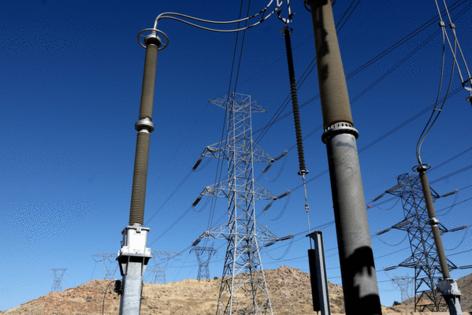Gov. Newsom orders study of California's ailing utility and insurance markets
Published in Business News
Gov. Gavin Newsom called Tuesday for a report that will study whether to limit the liabilities of California's investor-owned utilities if they're found to have caused wildfires — as well as to possibly establish a state-supported property insurance fund.
The executive order is more broadly intended to come up with ideas on how to reduce the risk and better share the cost of wildfires — as well as to shore up California's insurance market and investor-owned utilities — following the devastation caused by the Los Angeles County blazes in January.
"There's no Republican or Democratic thermometer — red and blue state alike, and countries around the world, are facing this climate-fueled insurance crisis. And California is taking action," Newsom said in a statement accompanying his order.
The report was required by Senate Bill 254, a bill Newsom recently signed to replenish the state's $21-billion wildfire fund. The bill would add $18 billion to the fund, split by contributions from utility customers and investors.
The fund was established in 2019 to act as a financial backstop for Southern California Edison and the state's other investor-owned utilities amid the growing severity and frequency of wildfires, but there are fears it could be depleted by Altadena's Eaton blaze, which may cost insurers $15 billion.
SB 254 called for a report that would recommend "new models" to mitigate damage, accelerate recovery and equitably "allocate the burdens" of wildfires, earthquakes and other natural disasters among homeowners, insurers, utilities and others, but it otherwise lacked specificity.
Newsom's order requires the California Public Utilities Commission, the Department of Insurance and multiple other state agencies to produce the report by April that will focus on a few main areas.
They include lessening fire risks through high-tech and other mitigation measures; ensuring the availability of insurance and affordable energy; assisting homeowners and communities in recovering from disasters; and ensuring wildfire losses are promptly and fully paid.
"These are all familiar concepts that we've been discussing for months, and in some cases, years," said Rex Frazier, president of the Personal Insurance Federation of California, a trade group representing the state's large property and casualty insurers.
However, he took aim at a provision that calls for studying the "potential benefits and potential negative impacts" on homeowners if there are restrictions placed on damages from lawsuits filed against electric or gas utilities found to have caused wildfires.
"We continue to argue that it's critical to have safety incentives for utilities, and letting them cause fires and not pay for them is the worst safety incentive there is," Frazier said.
While an official cause of the Eaton fire has not been established, Edison has acknowledged its power lines may have played a role and the company has been sued by insurers, public entities and others seeking compensation. The study also will seek recommendations on how to hold "electrical corporations accountable for improving safety and reducing the risk of catastrophic wildfires."
Frazier noted there was a push to limit utility wildfire liability after a series of devastating fires in 2017 and 2018 that ultimately forced Pacific Gas & Electric to file for bankruptcy.
The 2019 law backed by Newsom that created the wildfire fund significantly limited the liability that utilities have for catastrophic wildfires sparked by their equipment. Possible additional curbs on liabilities to be studied could include limits on attorney fees, and economic and noneconomic damages due to claims by insurers and public entities, as well as those outside fire zones.
Southern California Edison spokesperson Scott Johnson declined to comment on Frazier's criticism and said: "We certainly thank Gov. Newsom for taking this important action, and we look forward to working with the respective state entities and stakeholders to develop meaningful and affordable solutions to address the increasing risks from climate-driven catastrophic events."
Other provisions in the order call for the report to study "alternative structures to socialize risk of damage from natural catastrophes" — and to study "new models" to replace or complement the wildfire fund such as "state-supported property insurance, or reinsurance," as well as a "publicly supported safety net to enhance long-term resilience and utility and insurance rate affordability."
Jamie Court, president of Consumer Watchdog, a leading Los Angeles advocacy group, agreed with Newsom that it is important to consider some sort of public insurance option but was skeptical much would come of the effort.
"It's just a question of whether anything's going to get done, because he only has a year left in office," he said.
Consumer Watchdog, he noted, worked on a bill that would have leveraged the state's credit rating to assist in lowering the cost of reinsurance, which is bought by insurers to protect themselves from catastrophic claims. However, it never got off the ground.
Newsom said Tuesday in his news release that California has already made progress in reforming its insurance market following an executive order he issued in 2023 that supported Insurance Commissioner Ricardo Lara's Sustainable Insurance Strategy.
That strategy, which is just being implemented, has sought to entice insurers to write policies in fire-prone neighborhoods, but has been criticized by some consumer advocates as a giveaway to the insurance industry. Lara issued a statement Tuesday praising the governor's latest order.
"Our shared goal is to ensure that every Californian has peace of mind, knowing they can recover and rebuild after a disaster, regardless of their ZIP Code or income level," he said.
(Los Angeles Times staff writer Melody Petersen contributed to this report.)
©2025 Los Angeles Times. Visit at latimes.com. Distributed by Tribune Content Agency, LLC.












Comments